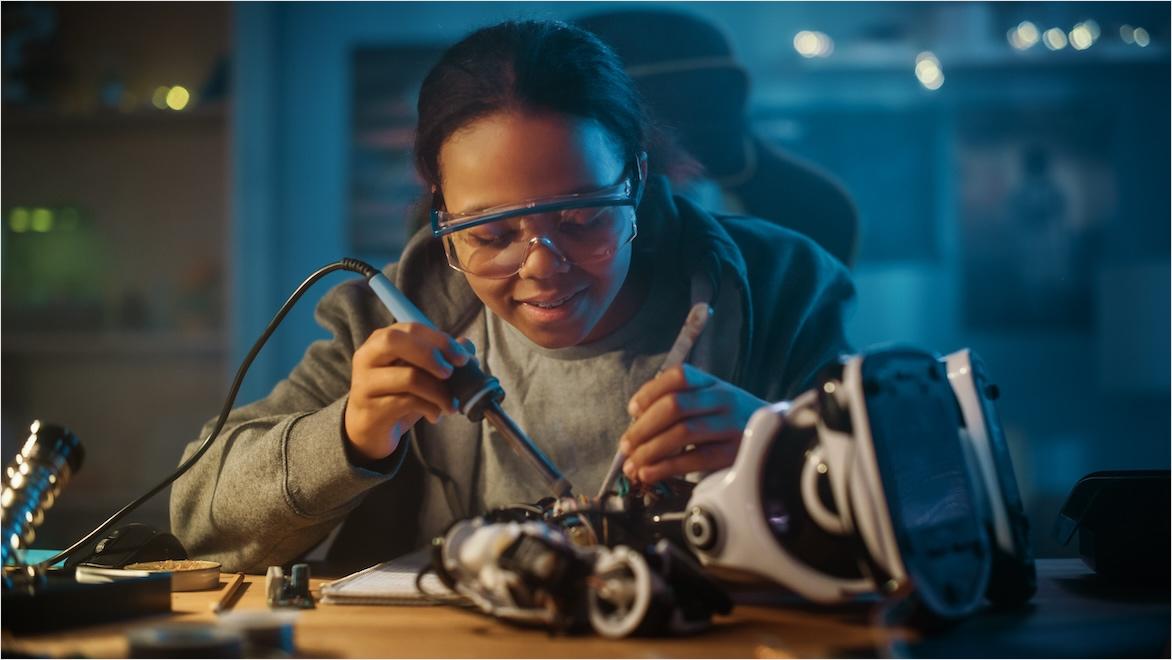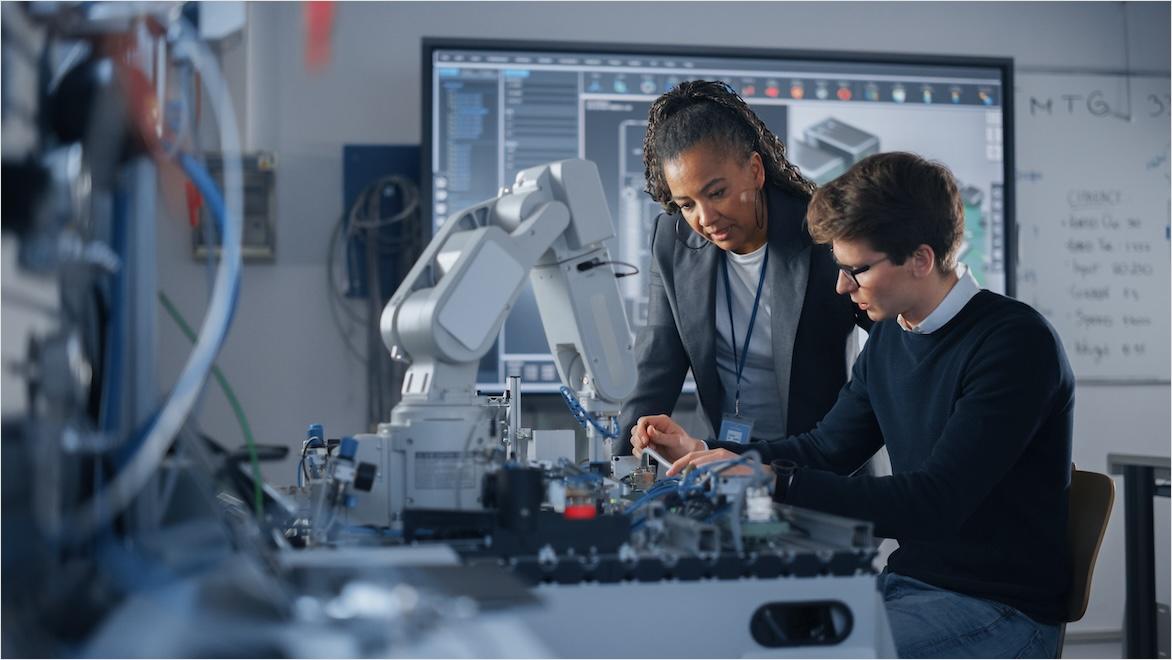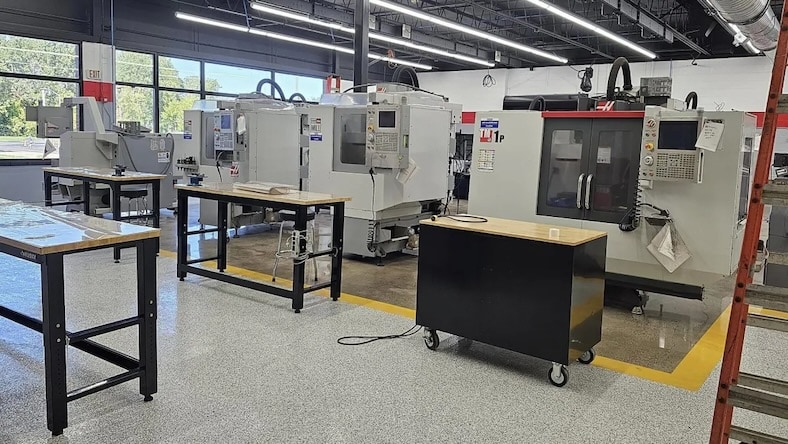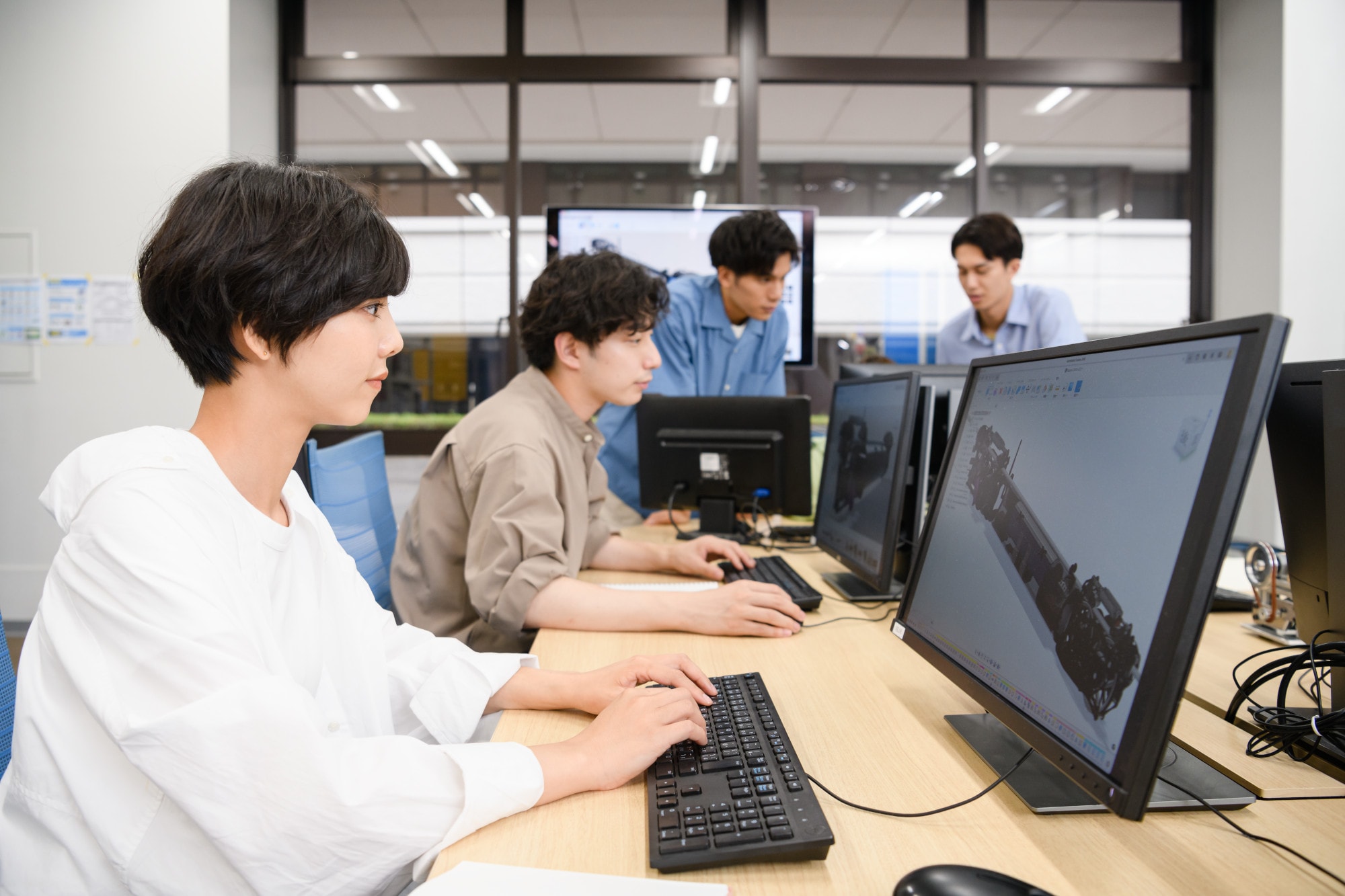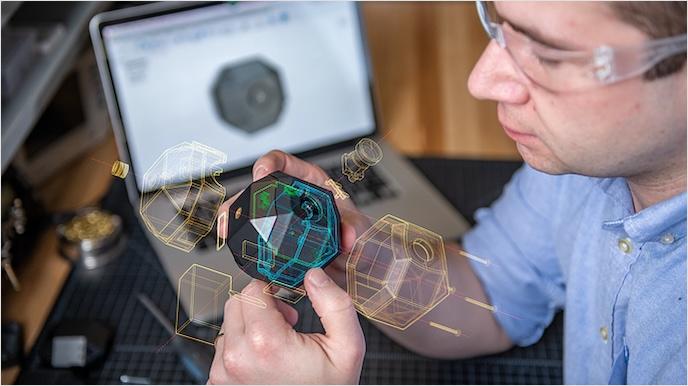& Construction

Integrated BIM tools, including Revit, AutoCAD, and Civil 3D
& Manufacturing

Professional CAD/CAM tools built on Inventor and AutoCAD
STEM education—science, technology, engineering, and mathematics—is an interdisciplinary, hands-on approach to learning where students develop in-demand technical and durable skills to identify problems, prototype and iterate solutions, and apply emerging technologies like AI (artificial intelligence), BIM (building information modeling), and robotics. For industries such as AECO (architecture, engineering, construction, and operations), PD&M (product design and manufacturing), and M&E (media and entertainment), STEM education is the foundation of building a resilient, innovative business and future-ready workforce. For students and job seekers, STEM education is the pathway to the in-demand skills and high-paying careers of today and tomorrow, from automation and sustainability to the converging roles developed to meet the demands of our rapidly changing world.
Science explores the natural world through observation, experimentation, and analysis, providing the foundation for solving real-world challenges.
In AECO, science drives advancements in digital transformation, budget efficiencies, safety, sustainable materials, energy-efficient design, and climate-responsive construction. It supports the development of green building technologies like self-healing concrete and bio-based insulation. In PD&M, science informs the creation of durable, lightweight materials, while in M&E, it enhances the understanding of color theory, acoustics, and human interaction with media.
Technology refers to tools, systems, and innovations that solve problems, enhance efficiencies, and transform industries. It includes advancements like software, robotics, AI, and communication networks.
In AECO, tools like BIM and digital twins revolutionize design and project management. In PD&M, 3D printing and IoT (Internet of Things) technologies enable more innovative and sustainable manufacturing. In M&E, innovations like virtual and augmented reality elevate acting, world-building, and storytelling.
Engineering applies science and technology to design, build, and optimize systems, structures, and processes, turning ideas into practical solutions.
In AECO, engineering ensures resilient, sustainable buildings and infrastructure. In PD&M, it enhances product performance and reduces waste through innovative design. In M&E, engineering merges technical precision with creativity to develop state-of-the-art rigs, sets, and immersive experiences.
Mathematics studies numbers, patterns, and relationships, serving as a universal analysis, modeling, and optimization tool.
In AECO, math underpins structural calculations, cost estimation, and project scheduling. For PD&M, it powers CAD (computer-aided design) and production optimization. In M&E, math drives animation, coding, and algorithms, enabling seamless CGI and motion capture.
STEM serves as a cornerstone for education, equipping students with the critical thinking, creativity, and problem-solving skills to thrive in a technology-driven world. By concentrating on science, technology, engineering, and mathematics, STEM education fosters interdisciplinary learning and innovation while preparing students for an evolving job market. This approach develops adaptability and encourages students to tackle complex, real-world challenges with confidence.
In education, prioritizing STEM creates opportunities to align curricula with industry needs and technological advancements. Equipping classrooms with tools like 3D printers, robotics kits, and VR (virtual reality) systems enables hands-on, immersive learning experiences. Partnerships with industries further enhance education by providing mentorship, internships, and exposure to real-world applications, building direct pathways to careers in high-demand fields.
STEM-focused institutions also work to improve learning access for all by addressing barriers to participation, such as gender, geography, and resources. Empowering learners from all backgrounds to pursue STEM opportunities drives innovation and, in the end, helps industries better understand and respond to the needs of their global audiences.
Free access to Autodesk Fusion provides hands-on experience to modern industry workflows, preparing students with practical experience that increases workforce readiness for jobs across industrial design and manufacturing to machining and 3D modeling.
Students stand out in competitive markets by earning credentials in Autodesk Revit and Autodesk Civil 3D, validating in-demand skills and strengthening their appeal with hiring managers.
From design to done, students gain an end-to-end understanding of how to bring a product to life that develops in-demand skills and strengthens their hiring potential.
Autodesk Construction Cloud provides students with the ability to understand the construction project lifecycle, from preconstruction to closeout or project handover onto facilities management, also known as operations and maintenance.
At Autodesk, we believe STEM education empowers the next generation to succeed in the jobs of the future. That’s why we are committed to providing free access to our full portfolio of software to students, educators, and administrators, and supporting education institutions around the world. To support this commitment, we are working to change the perception of skills and jobs in STEM and Design and Make industries, and building the bridge between education and industry, helping ensure current and future generations are equipped to solve our most pressing challenges.
FUSION
Simulate forces, test materials, and bring scientific concepts to life through digital prototyping.
Autodesk CONSTRUCTION CLOUD
Manage construction workflows and collaborate in real time using Autodesk Construction Cloud.
REVIT
Build bridges, machines, and sustainable structures using industry-grade engineering tools.
FUSION
Apply geometry, logic, and measurement to create accurate, data-driven 3D designs.
GALLATIN COLLEGE MSU
See how one instructor at Gallatin College, Montana State University saves time and better prepares students with Haas and Autodesk Fusion curriculum.
Image courtesy of Montana State University
SUNCOAST TECHNICAL COLLEGE
Discover how Suncoast Technical College prepares students for today’s industry needs with Haas and Autodesk Fusion curriculum.
Image courtesy of Suncoast Technical College
ORLEANS CAREER AND TECHNICAL EDUCATION CENTER
Learn how Orleans Career and Technical Education Center provides students hands-on opportunities in CNC machining and Autodesk Fusion.
Image courtesy of Bill Rakonczay
Offering software focused on digital transformation, automation, and sustainability, Autodesk is trusted by Design and Make industries, from architecture and manufacturing to media and entertainment. Our deep connection to industry along with our close collaboration with education institutions allows us to bridge this gap, equipping STEM learners, educators, and professionals with the skillsets, toolsets, and mindsets necessary to lead and thrive in a rapidly advancing, tech-driven world. Tools like Tinkercad, Fusion, Autodesk Construction Cloud, and Revit empower students and professionals to tackle real-world challenges through hands-on learning and innovative problem-solving.
Autodesk offers free, renewable access to our full portfolio of Design and Make software—like Fusion, Revit, and Autodesk Construction Cloud—for eligible students and educators, including those in STEM fields. Our education plan empowers the next generation to gain hands-on experience with professional-grade tools and learn in-demand skills for STEM careers in Design and Make industries. Simply verify your enrollment or teaching role to start experiencing the same technology used to build the world around us.
What if learning felt like crossing the finish line? STEM Racing brings STEM to life through the thrill of designing and racing miniature F1 cars. In collaboration with Autodesk, educators and students receive free access to professional software and classroom resources; this hands-on approach goes beyond textbooks, fostering crucial creativity, collaboration, and the future-ready skills students need to thrive.
AI is transforming education and the AECO industry by driving efficiency, innovation, and personalized solutions. In education, AI-powered tools provide adaptive learning, tailored feedback, and virtual tutoring, equipping students with skills for a tech-driven future. In the AECO sector, AI transforms project delivery through tools like Autodesk Forma, offering real-time environmental analysis and faster design iterations.
AI is enhancing education and the PD&M industry by fostering innovation, efficiency, and personalized learning experiences. In the D&M industry, AI optimizes design processes with generative design tools to create innovative, sustainable products while reducing material waste and development time. Tools like Autodesk Fusion integrate AI to streamline workflows, from conceptual design to production, bridging the gap between creativity and precision.
AI is improving education and the M&E industry by enhancing creativity, efficiency, and personalized learning. In the M&E sector, AI accelerates production workflows and elevates storytelling through automation and intelligent data management. Autodesk Flow, the industry cloud for M&E, exemplifies this transformation by connecting workflows, data, and teams across the production pipeline, enabling seamless collaboration and more efficient content creation.
While some industries have yet to fully embrace the power of AI, others are well beyond the planning phase. Across Design and Make industries—AECO, PD&M, and M&E—data from Autodesk’s 2024 Skills in the Age of AI survey shows that the growing availability and usage of AI tools is having an impact on how organizations approach hiring new talent and reskilling or upskilling their current workforce.
Autodesk is proud to be a sponsor of the National STEM Festival, joining forces with EXPLR Media to inspire and prepare the next generation of innovators and problem-solvers. As a leader in Design and Make software, Autodesk empowers students to turn ideas into reality, fostering creativity and practical skills in STEM disciplines. The partnership amplifies the Festival’s mission to guide bright minds toward STEM careers by offering hands-on learning opportunities, mentor sessions, and access to groundbreaking tools.
For over 18 years, Autodesk has partnered with WorldSkills to inspire and empower the next generation of skilled professionals in Design and Make industries. This global collaboration highlights Autodesk’s commitment to equipping students with the tools, experiences, and credentials needed to thrive in a rapidly-evolving workforce.
Autodesk Education teams collaborate with SkillsUSA to empower the next generation of innovators by providing access to industry-leading tools and training resources. Through this partnership, SkillsUSA students and advisors gain free access to professional-level Autodesk software, including Fusion, a comprehensive platform that integrates CAD, CAM, CAE, and PCB design.
The STEM methodology integrates science, technology, engineering, and mathematics into an interdisciplinary framework that emphasizes real-world applications and problem-solving. By encouraging hands-on, inquiry-based learning, it mirrors how these disciplines interact in professional contexts, fostering critical thinking, creativity, and collaboration. STEM equips students with the skills needed to address complex challenges in a tech-driven world and prepares them for high-demand industries.
STEM in early childhood education fosters curiosity, critical thinking, and problem-solving skills at a formative age. By engaging in hands-on activities like building, observing nature, or exploring basic coding, young learners develop a deeper understanding of the world and gain confidence in their problem-solving abilities. Early STEM exposure nurtures collaboration, logical reasoning, and a growth mindset while inspiring interest in STEM fields. This foundation prepares children to tackle more complex concepts later, setting them on a path for academic and career success.
A STEM student is someone engaged in learning or pursuing studies in science, technology, engineering, or mathematics at a foundational or advanced level. These students focus on critical thinking, problem-solving, and innovation, often applying interdisciplinary approaches to real-world challenges. Their studies may include topics like coding, robotics, environmental science, or engineering design, preparing them for careers in fields such as health care, aerospace, technology, and manufacturing. STEM students are driven by curiosity and a desire to create solutions for the future.
STEM activities are hands-on tasks that integrate science, technology, engineering, and mathematics to encourage critical thinking, creativity, and problem-solving. These range from simple experiments, like making a baking soda volcano, to advanced projects, such as designing robotic arms or sustainable energy models. Often involving teamwork and exploration, STEM activities help learners apply interdisciplinary concepts to real-world challenges while fostering curiosity and confidence. Suitable for all ages, they prepare participants for academic and professional success by building foundational skills in innovation and inquiry.
A STEM school integrates science, technology, engineering, and mathematics into its curriculum, emphasizing interdisciplinary, hands-on learning that fosters critical thinking, creativity, and problem-solving. These schools offer project-based learning, advanced technologies like robotics and 3D printing, and access to industry partnerships for mentorship and real-world experience. Focused on inclusivity and innovation, STEM schools prepare students for success in a tech-driven world and high-demand careers by equipping them with practical skills and a strong foundation in STEM disciplines.
Teaching itself isn’t considered a STEM profession, but those who teach science, technology, engineering, or mathematics play a vital role in the STEM ecosystem. STEM educators inspire curiosity and critical thinking by connecting classroom concepts to real-world applications through hands-on, interdisciplinary lessons. Teachers are essential in preparing future STEM professionals and equipping students with problem-solving and innovation skills. Even educators in non-STEM subjects can contribute by integrating STEM concepts, fostering interdisciplinary learning, and demonstrating STEM’s relevance across different fields.
Free Autodesk software and/or cloud-based services are subject to acceptance of and compliance with the terms and conditions of the terms of use and/or other terms that accompany such software or cloud-based services. Software and cloud-based services subject to an Educational license or subscription may be used by eligible users solely for Educational Purposes and shall not be used for commercial, professional or any other for-profit purposes.
